California’s “Greatest Mountain Man”
The Legacy of Grizzly Adams
One of the most amazing frontier biographies ever documented is the story of the ‘real’ Grizzly Adams.
A western mountain-man legend, Grizzly Adams’ birth name was ‘John Capen Adams’ when he was born in Medway, Massachusetts in 1812. He was the second eldest of seven siblings who grew up in a rural farm household run by his father and mother, Eleazer and Sibel Adams. His impressive family tree included two United States presidents and Revolutionary War patriot, Samuel Adams.
As he grew to manhood, John C. Adams recognized a unique ability he had when it came to understanding the behavior of wild animals. This talent came in handy when he was hired to help manage a traveling display of wild animals shipped over from Africa. The twenty-one year old Adams was employed as a caretaker for the troupe until fate played its hand when he was nearly killed by a Royal Bengal Tiger. Bedridden for months, after enduring a year-long recovery process he then opted for a safer trade as shoe cobbler, something his father had him apprentice at during his teen years.
In due time, while still a young man, John C. Adams started his own business making shoes and boots in Boston, just as former President John Adams’ father had done. He also married one Cylena Drury and began raising a family. In 1849, however, he and his father lost their combined savings in a business venture that went up in flames causing financial ruin to both, that subsequently led Eleazer Adams ending his own life. After that, a despondent John C. Adams left Boston a broken man to head west with the multitude of other Great California Gold Rush participants, promising to send money home whenever he could.
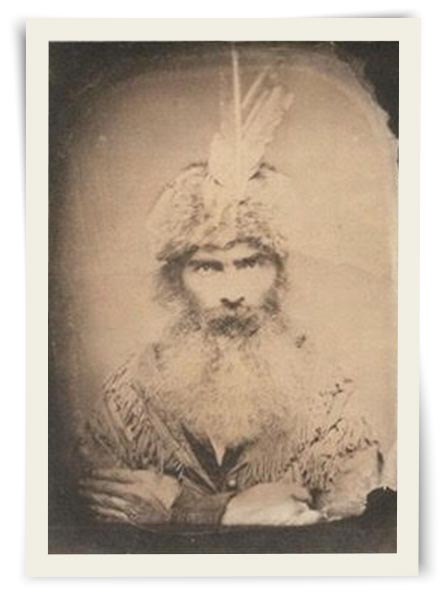
Celebrated showman Grizzly Adams in
San Francisco, cira 1858
In California, after the “numerous hardships and privations” Adams endured getting there, he settled near Stockton where he began mining for gold. He was industrious and soon became a land owner and an employer of several men who helped run his own sluice operation. Unfortunately though, his trusting nature enabled low-end business sharks to repeatedly con him out of his gold claims, to a point where by late 1852 he’d had enough, and decided to turn his back on civilization.
Once again disheartened by misfortune, John C. Adams had finally had enough, and decided to set out with his last meager provisions he loaded onto a creaky ox-cart he, “needed to soak for a week” in order to keep it together. He then pointed himself toward highland wilderness of central California, and after trekking a hard two-hundred miles he stopped near the great Yosemite Valley where he built a cabin surrounded by wildlife and Native American tribes—just in time for winter to set in. He later recalled that period of solitude as the ‘most satisfying’ of his entire life.
“In the fall of 1852, I abandoned all my schemes for the accumulation of wealth, turned my back upon the society of my fellows, and took the road toward the wildest and most unfrequented parts of the Sierra Nevada, resolved thenceforth to make the wilderness my home, and the wild beasts my companions.”
While adapting to his new environment, John C. Adams learned to commune with nature and to become an expert hunter, tracker, and provider for himself and his Miwok Indian neighbors. As well, beyond engaging in his newfound hobby of collecting a wide variety of living wild animals, he also captured, raised, and trained grizzly bears lending to his soon earned nickname of “Grizzly Adams.”
Using some of his trained bears as pack animals, Grizzly Adams led many tracking expeditions far and wide through the western frontier, always disembarking from his central California encampment. He not only managed to traverse the bulk of California, but he trekked well beyond its limits as far north as the Canadian border, as far south as the Mojave Desert, and as far east as Montana and Salt Lake City. He generally hired Indian scouts to help him on his journeys as well, further solidifying his relationships with different tribal leaders as his ‘Grizzly Adams’ legend grew. So much marked a key difference with Grizzly Adams when compared to other mountain men of his era, who often boasted themselves to be ‘Indian hunters’ as well. Lest if be forgotten that many ‘down on their luck’ gold miners making under a dollar a day found it hard to resist the “$5 each” offer for Native American scalps.
Grizzly Adams saw things differently. He spoke highly of the integrity of the Native Americans he befriended, worked with, and traded with. He also described them as “fair and honest people” in their lives and doings, and he greatly valued the symbiotic relationship he nurtured with them.
For a few years, into 1856, Grizzly Adams tracked, hunted, and collected animals for a living during his self-exiled mountain-man life until he grew tired of it, and he opted to relocate to San Francisco after being offered a chance to make money by putting on shows with his live bears and other animals. [Note: Grizzly Adams was erroneously described in some accounts as a person who had ‘hunted relentlessly in the mountains for ten years.’ This was far from the truth. The total time he spent in California mountain ranges was about two and a half years, during which time he scouted, hunted, and traded with Native Americans who much appreciated the supplement of meats and furs his skill afforded them. Not to leave out, hunting was a way of life back then and and frontiersmen such as Davy Crockett and Daniel Boone were also renowned for their prowess at it. It is true, however, different hunting methods common in the 1800’s are unthinkable today, with many having been outlawed over the years.]
~~~
In 1856, Grizzly Adams entered San Francisco in grand fashion with a parade on Market Street featuring his large menagerie of bears and other animals. He began running his own enterprise there while readapted to city life, and in due time he and his ‘Mountaineer Museum’ became so popular that news reporters started to take notice. One young reporter in particular, Theodore Hittell, wrote an impressive series of articles about Grizzly Adams and his animals causing the new city-dwelling mountain man to attain celebrity status. [Hittell would eventually go on to become a recognized California historian.]
Adams was initially billed as “The Wild Yankee” at Thomas Maguire’s opulent Opera House and his Theater Americana in San Francisco, but the name was soon replaced by his more recognizable moniker, “Grizzly Adams.”
For four years, Grizzly Adams regularly performed with his bears and other animals in his cavernous Mountaineer Museum (located in the basement of the former Stock Exchange building) and San Francisco’s most notable theater venues. With his favorite grizzly bear companions, Benjamin Franklin, Lady Washington, Funny Joe and General Fremont, he embraced his newfound notoriety that left him greeting the likes of future Civil War General, William Tecumseh Sherman, Levi Strauss, Domingo Ghirardelli, and the indomitable Lola Montez, AKA “the Countess of Landsfeld” as she was known during her European days. (Miss Montez had her own pet grizzly bear and was known for performing her infamous ‘Spider Dance’ to throngs of wage-spending miners, and for her dalliances with some of San Francisco’s upper-crust male denizens.)
Within the sordid political scene of San Francisco then, Grizzly Adams also witnessed Governor Neely Johnson’s controversial vigilante’s movement of the mid-1850’s that had been assembled to curtail the city’s reputed lawlessness.
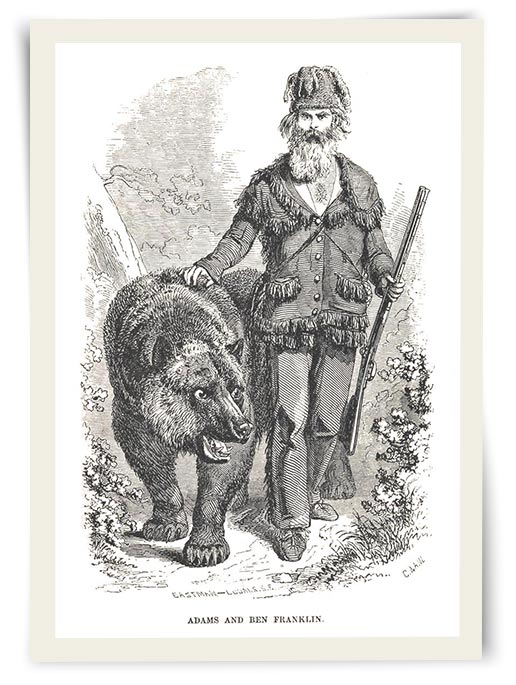
Famous goldrush era artist, Charles Nahl’s 1856 woodblock etching of Grizzly Adams along stride of his favorite pet grizzly bear, Benjamin Franklin
Notwithstanding the city’s many other entrapments, Grizzly Adams ended up enjoying his new life there more than he thought he would. Always wearing his buckskins, he could often be seen strolling with his favorite bear, Ben on Kearny Street to one of its several different restaurants he would choose to dine at—while the docile bear remained tethered outside in his sight. His extensive overhead required significant funding, though, as the bulk of his animals, especially his bears had special boarding needs that required much tending from hired help, and so much food that it proved difficult for the mountain man turned ‘showman’ to get ahead financially.
No matter, for Theodore Hittell, the aforementioned reporter who wrote for the San Francisco Bulletin, was so taken by Grizzly Adams that he ended up compiling enough journals about the mountain man it enabled him to assemble a vast chronological account of Grizzly Adams’ fascinating adventures. For whatever reason, though, Grizzly Adams, who often used aliases while out west, used the name of his brother, ‘James’ to identify himself to Hittell, leaving him to be mistakenly attributed in Hittell’s later published work about him as, ‘James Capen Adams.’
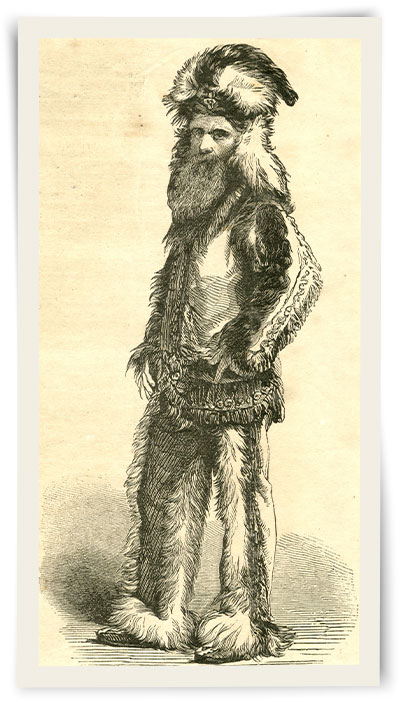
Daguerreotype of Grizzly Adams by famous Civil War photographer Mathew Brady in Leslie’s Illustrated Newspaper 1861
~~~
As the novelty of his animal shows began to fade, fate again stepped in to play its hand with Grizzly Adams. First, he sustained a head wound during a wrestling exhibition with one of his bears that proved difficult to heal. Not too long after that, in late 1858, an unknown illness caused the death of his star bear, Benjamin Franklin that left Adams heartbroken. Realizing his health was in jeopardy due to his head wound, and still grieving over the loss of Ben, (the bear received a celebrity-worthy eulogy in the paper) Grizzly Adams began longing for home and decided to leave San Francisco to head back to the east coast—to New York, specifically. He managed to do so with as many of his animals as he could load onto a ship that would sail him around Cape Horn on an epic ‘Noah’s Ark like’ adventure.
Grizzly Adams departed from San Francisco’s Bay harbor in early January of 1860, aboard the clipper ship, ‘Golden Fleece’ that he had loaded over sixty animals onto. His menagerie included his remaining bears, some foxes, wolves, antelope, a bald eagle, a few reptiles and a giant sea lion.
The arduous journey took three months, and Grizzly Adams, with his head already injured from bear wrestling, re-injured it during the ocean voyage doing the same thing, this time enough to where it left him coming to terms with the sharp reality of knowing he would never fully recover.
Grizzly Adams was as tough as they came though, and after he arrived in New York City he again proudly paraded his troupe of bears and other animals on Broadway while heading for the office of P.T. Barnum—where the famous showman, who had already purchased an interest in Adams’ impressive menagerie, quickly signed him to a performance contract. As Barnum’s ‘Old Grizzly Adams’ act became popular in New York City, Adams was also reunited with his wife, Cylena, who he had managed to send some money to via post by ships that dropped mail off in Panama’s western port to head overland to a new awaiting ship on the other side. This happened a few times during Adams’ long absence from his wife and three children. The couple’s reunion was bitter-sweet, though, as Adams’ health began failing to a point where Cylena found herself serving as a nurse for her decade-long estranged husband in between his performances.
By the fall of 1860, John ‘Grizzly’ Adams could no longer perform and Cylena felt it was best that he return to Boston so he could spend his last days with his family. Grizzly Adams soon after died on October 25, 1860, three days after his forty-eighth birthday, and just a few weeks before the election of Abraham Lincoln as President.
P. T. Barnum paid for Adams’ funeral and burial in Charlton, Massachusetts, in the same cemetery Adams’ father, Eleazer was buried, who had hung himself in 1849. The famous mountain man’s headstone is still there today; his wife, Cylena and one of their daughters are buried near him.
There is no measuring the influence Grizzly Adams had on P.T. Barnum, especially when it came the way the famous show promoter viewed the profitable future of circus animals. The legendary Ringling Brothers and Barnum & Bailey Circus that lasted well into the Twenty First century gave testament to that. Certainly Adams was one of the original American animal pageant leaders to parade a large troupe of exotic wild beasts into major cities, a tradition that stuck with most all major circus acts later on, mostly for practical reasons, especially with elephants. Some of his animals also contributed to the start-ups of both the San Francisco and the New York City Zoos. It was even remarked how into the Twentieth Century, descendants of a few animals once owned and raised by Grizzly Adams were still attractions in both places.
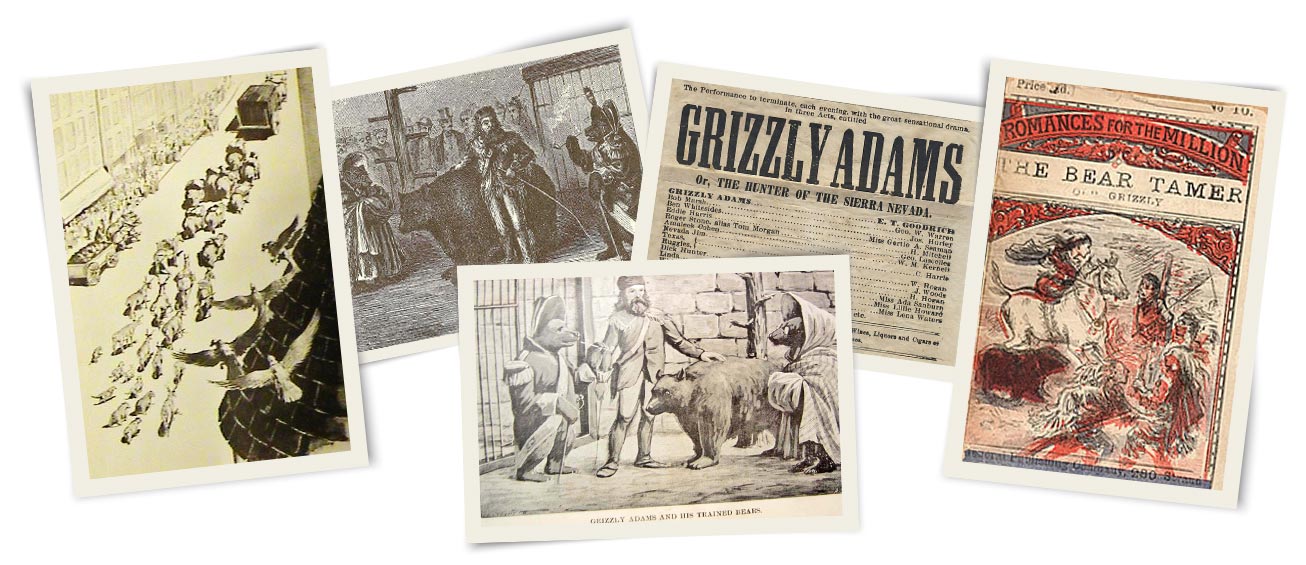
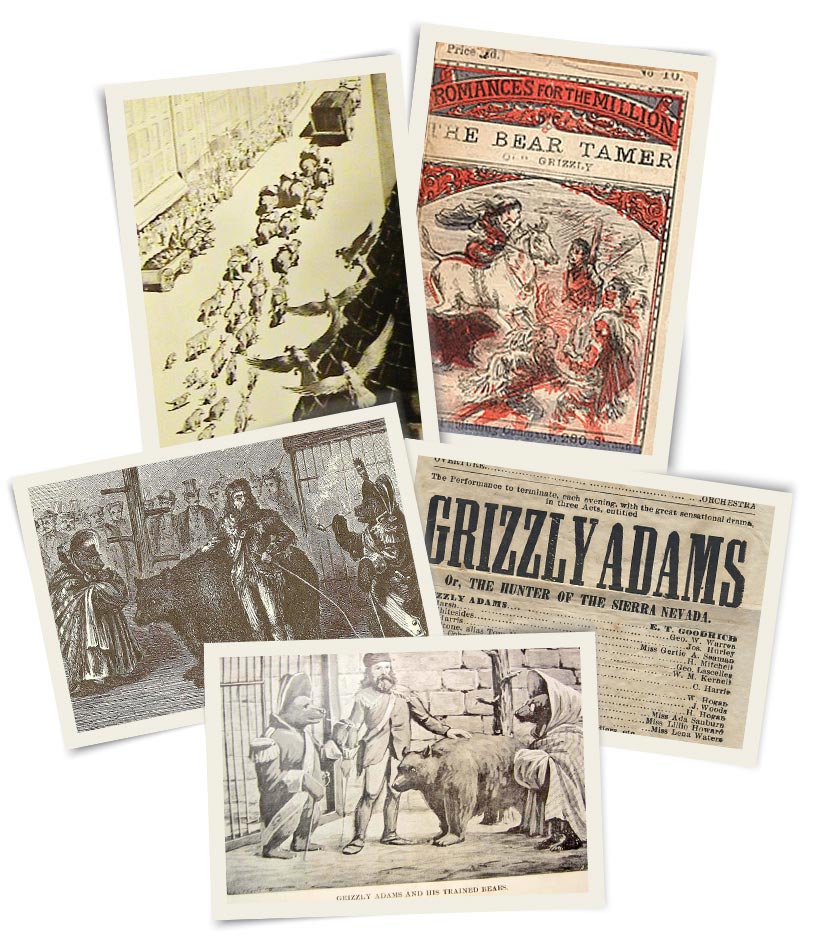
Epilogue
The incredible gold rush era story of Grizzly Adams is an epic saga that left an indelible stamp on modern American culture. His 1960’s biographer, Richard Dillon, even described Grizzly Adams as, “perhaps the greatest individualist California ever produced.”
Other written accounts of Grizzly Adams’ life along with the 1970’s motion picture and popular TV series inspired by his many exploits, left Grizzly Adams deservedly recognized with iconic status. It can even be said, the countless miles of north-to-south western frontier trails he blazed created a metaphor equal to one man’s settling of the west on his own terms.
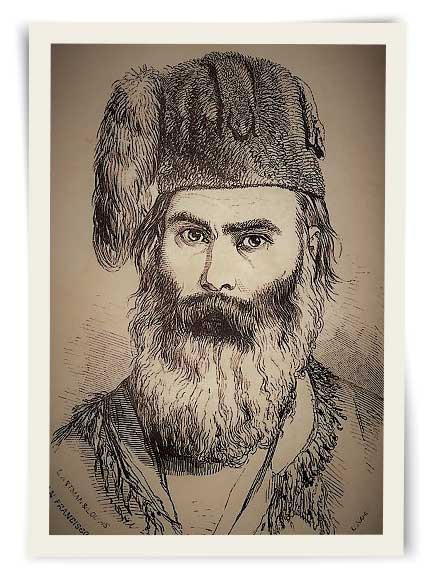
Charles Nahl drawing of Mountain
Man Grizzly Adams, 1856
Due to the numerous mis-projections about the life he led, the ‘famous historical American’ credit due to Grizzly Adams is truly lacking today. After all, few people, if any really, participated-in and then endured the California Gold Rush with the end result leaving them famous on both the west coast and east coast at the same time. It’s true, over a five year time period, from 1856 through 1860, Grizzly Adams became famous in both places. He was, perhaps, the first United States ‘coast to coast’ recognized celebrity after California became a state, before the advent of the Civil War erased the significance of his accomplishment.
No doubt the most surprising part of Grizzly Adams’ historic legacy appears on a famous flag. Few are aware that the same bear image seen for over a hundred years on California’s state flag was modeled after a grizzly bear named ‘Samson’, painted by famous western artist Charles Nahl in 1855. Even fewer realize that Samson was a huge, live bear that Nahl chose to paint, originally captured and owned by California’s greatest mountain man ever – the one and only, Grizzly Adams.
“In the fall of 1852, I abandoned all my schemes for the accumulation of wealth, turned my back upon the society of my fellows, and took the road toward the wildest and most unfrequented parts of the Sierra Nevada, resolved thenceforth to make the wilderness my home, and the wild beasts my companions.”
– Grizzly Adams
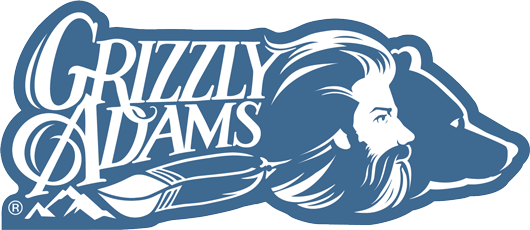
The term GRIZZLY ADAMS is a registered trademark of The Grizzly Adams® Company.
The Grizzly Adams® Company
8306 Wilshire Boulevard, #582
Beverly Hills, CA 90211
Email: [email protected]
